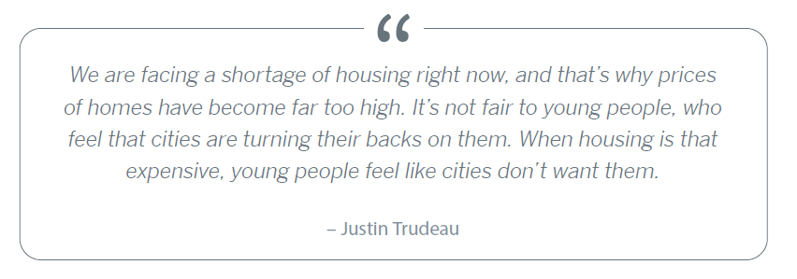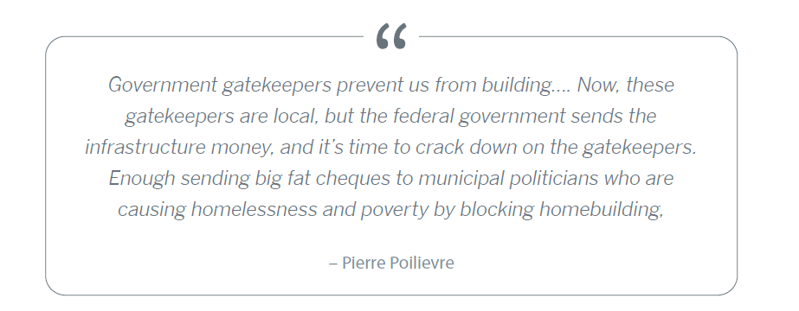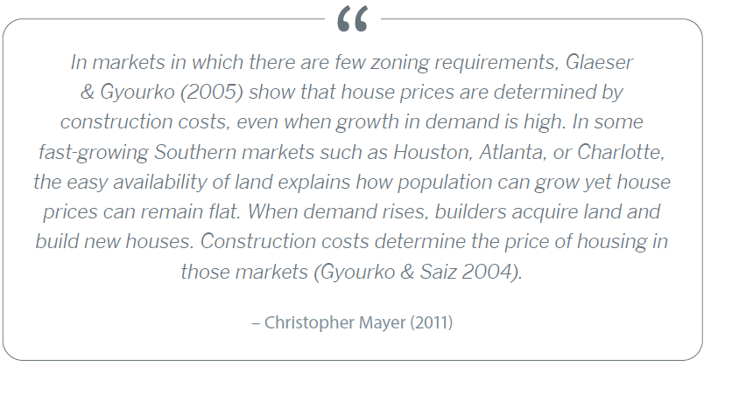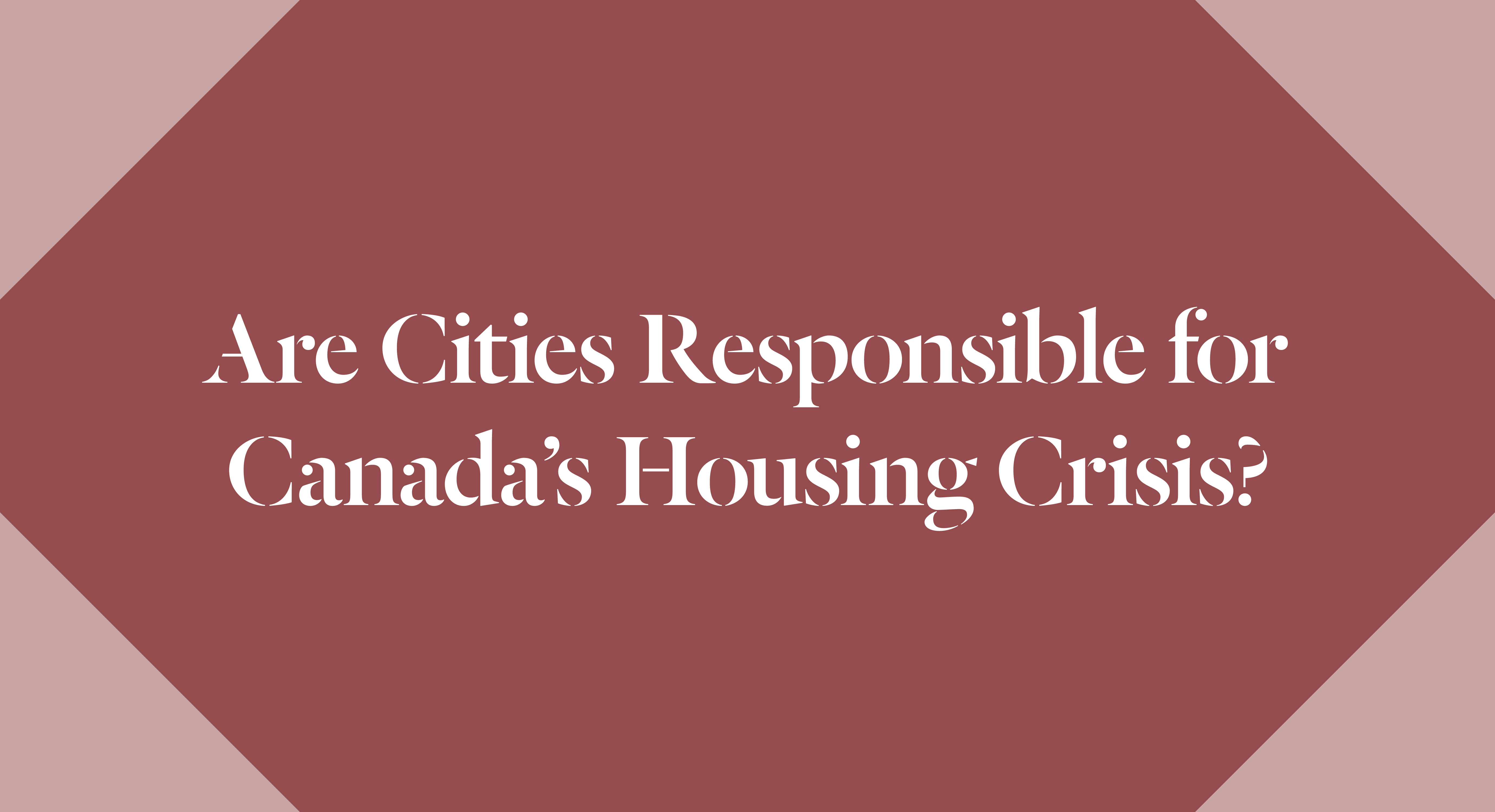For many at the federal level, it's convenient to blame cities for "gate-keeping" and "NIMBY" policies that prevent more housing from being built - is this fair?
While there is never one cause for rapidly rising home prices, most policy makers and experts will typically focus most of their attention, commentary and policy recommendations on the factor they think is having the biggest impact.
In Canada, governments and some economists put most of the blame on high home prices on a lack of supply of new housing and the primary culprit for this lack of supply, they argue, are municipalities and their restrictive policies that are preventing builders from increasing the supply of new homes.
Canada’s Prime Minister, Justin Trudeau and the leader of the Conservative Party, Pierre Poilievre, both blame cities for Canada’s housing crisis.


Canada’s politicians, with the help of their advisors, are likely leaning on academic theories that argue that housing markets with relatively few barriers to building homes should not see home prices rise rapidly because builders can rapidly increase the supply of housing to meet the increase in demand. These markets are said to have an elastic supply of housing because the supply can expand or grow easily, like an elastic band does.
Markets with an inelastic supply of housing (such as Toronto, San Francisco, New York) cannot increase the supply of housing quickly in response to an increase in demand. According to academics, this inelastic supply is often a primary driver of rapidly rising home prices.
The quote below from a paper by economist Christopher Mayer offers a succinct summary of this academic theory. I find this quote helpful because it does a great job of summarizing this overarching academic idea by referring to papers from some of the leading housing economists in the world.

Now, it should be noted that what the academic literature normally considers to be a ‘barrier’ is lack of land availability for residential construction, either due to physical constraints or zoning and other regulatory constraints, which in most areas are attributed to cities/municipalities policy-making.
To better assess the claims being made by our Prime Minister and Conservative leader Pierre Poilievre that the latter barriers are causing our national housing crisis, I am going to take a closer look at what the data suggests.
To do this, I will compare the appreciation in home prices in Toronto over the past ten years against cities that have achieved the goal our politicians argue all cities should strive for — removing regulatory barriers to building so builders can build homes freely. Build, Build, Build!
A good place to start is to compare the growth in home prices in Toronto against the cities cited above (Houston, Atlanta and Charlotte), which academics have argued should see flat price growth even when their population is growing quickly and demand for homes is increasing.
First, let’s compare the growth in population over the past ten years in each of these U.S. states against the growth in Ontario’s population.
From above, we can see that all three states have experienced significant growth in their population, ranging from 9.7% in North Carolina to 15.1% in Texas. Ontario saw its population grow by 13.1% over the same period.
Since the population in Texas is increasing even more rapidly than that of Ontario, it would be helpful to compare how home prices in a number of additional cities in Texas with elastic housing supply are changing. This will help us understand how home prices change in a rapidly growing state like Texas, whose major cities have a relatively elastic supply of housing.
The chart below compares the growth in home prices between 2012 and 2022 in a number of major cities in Texas, along with Atlanta and Charlotte. The cities are ordered by their housing supply elasticity, with the most elastic markets on the left (based on a paper by Albert Saiz). However, it is important to note that all of these U.S. cities have relatively high home supply elasticities as compared to Toronto.
It’s clear from the data above that these housing markets in the U.S. with high housing supply elasticities have not avoided a surge in home prices the way the theory suggests they should have. Home prices in four of the seven U.S. cities rose more rapidly than in Toronto. Furthermore, even with the second-highest supply elasticity, Austin saw home prices rise the fastest.
It’s worth noting that if we look back to the late 1990s and early 2000s, the price growth in all of the above U.S. cities was relatively modest when compared to a U.S. city like San Francisco, which has an inelastic supply of housing. But over the past ten years, four out of the seven U.S. cities with an elastic supply of housing saw prices rise even more rapidly than San Francisco.
This rapidly rising home prices have deteriorated housing affordability in Texas. A recent report from the Wall Street Journal found that the percentage of homes affordable to families wearing a median income has plummeted since 2014.
It’s beyond the scope of this report to explain why this unexpected finding is happening — further research into each local situation is required. But the price growth appears to contradict what politicians and academics have been telling Canadians — that high home prices are caused by cities restricting housing supply and that if cities remove these restrictions, housing will be more affordable.
Let’s now turn to Ontario’s housing market to compare how home prices have changed across cities with far more elastic housing supply than that of Toronto.
The Bank of Canada has calculated the housing supply elasticity for a number of major cities across Canada, as seen in the chart below.
From the above, we can see that of all southern Ontario cities, which are the most densely populated in the province, Toronto has the lowest housing supply elasticity while London, Kitchener-Waterloo, Guelph, St. Catherine’s-Niagara, Barrie and Windsor have the highest. London, with a housing supply elasticity of 19.6, was excluded from the Bank of Canada’s chart for visualization purposes.
Again, per the academic theory, these cities should see a more modest increase in home prices when compared to Toronto.
The chart below shows the growth in home prices from 2012 to 2012 for the above cities. Cities are ordered by their housing supply elasticity, with cities with the highest elasticity on the left.
From above, again we see that the theory does not really stand up to reality. All six cities in southern Ontario that have higher housing supply elasticities saw home prices rise more rapidly than in Toronto.
This does not mean cities should not introduce policies that encourage more housing. Canada needs to build more housing, and policies that speed up the approval of new housing and encourage more density are important steps in increasing the supply of housing. However, the above results suggest that high home prices are not only due to barriers restricting the housing supply.
If our governments and academics cannot point to a single country or state anywhere in the world that has rapidly increased its supply of housing amidst a rapid population boom to keep home prices affordable, then are their promises to Build, Build, Build! our way out of this housing crisis an honest solution, or an unattainable goal that will only drive home prices higher?
I suspect the latter.
The fact is that the supply of housing is relatively fixed in the short-term. Our federal government can estimate the number of homes that will be completed over the next year or two based on the number of homes under construction today.
Suppose our government allows Canada to grow by over 1 million people per year (three times faster than historical trends and among the fastest growth rates in the world) in a year when they know only 200,000 homes are going to be completed. In that case, they have decided to allow for housing prices and rents to be pushed up, pushing more people and families into housing unaffordability and worse.
When our government keeps making this same decision year after year, we end up with a housing crisis and a housing shortage that keeps getting worse.
Our federal government appears to have wanted all of the economic benefits that a rapid population boom brings without investing any time into considering where everyone will live. Now that all Canadians, especially the poorest households, are experiencing the negative effects of rapidly rising housing costs, our federal government is trying to blame cities for their decisions that are the primary cause of Canada’s housing crisis.
We should all be more suspicious of these claims.
John Pasalis is President of Realosophy Realty. A specialist in real estate data analysis, John’s research focuses on unlocking micro trends in the Greater Toronto Area real estate market. His research has been utilized by the Bank of Canada, the Canadian Mortgage and Housing Corporation (CMHC) and the International Monetary Fund (IMF).




